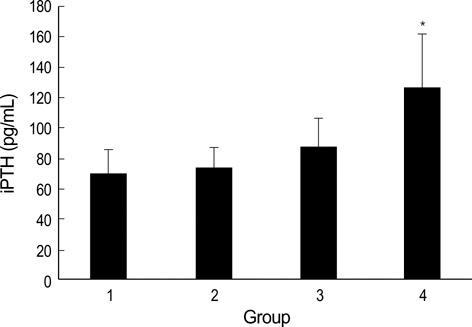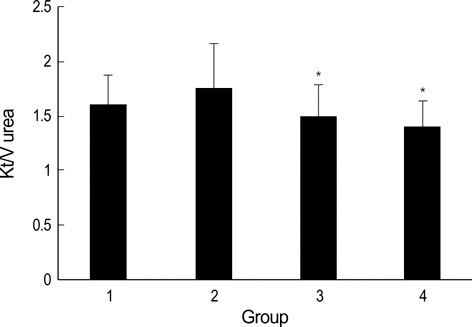J Korean Med Sci.
2007 Aug;22(4):604-610. 10.3346/jkms.2007.22.4.604.
Associations between Sympathetic Activity, Plasma Concentrations of Renin, Aldosterone, and Parathyroid Hormone, and the Degree of Intractability of Blood Pressure Control in modialysis Patients
- Affiliations
-
- 1Department of Internal Medicine, Soonchunhyang University College of Medicine, Cheonan, Korea. hwgil@sch.ac.kr
- 2Department of Medical Informatics & Epidemiology, Soonchunhyang University College of Medicine, Cheonan, Korea.
- 3Department of Biostatistics, Soonchunhyang University College of Medicine, Cheonan, Korea.
- KMID: 1127073
- DOI: http://doi.org/10.3346/jkms.2007.22.4.604
Abstract
- This study was designed to examine how such factors as hemodialysis parameters, body mass index, renin and aldosterone concentrations, sympathetic nervous activity, and parathyroid hormone concentrations are associated with the control of hypertension in hemodialysis patients. Hemodialysis patients (n=114) were grouped into four categories. Group 1 had normal BP without antihypertensive medication. Group 2 needed one antihypertensive drug, Group 3 needed combination of two or three categories of antihypertensive drugs without minoxidil. Group 4 needed more than three categories of antihypertensive drugs including minoxidil. Parathyroid hormone, beta2-microglobulin, renin and aldosterone, epinephrine, norepinephrine, and hemodialysis parameters were measured. The fractional clearance of urea as Kt/V urea was significantly lower in Group 3 and Group 4 than in Group 2 (p<0.01). Concentrations of parathyroid hormone were significantly higher in Group 4 than the other groups (p<0.01). Pre-hemodialysis norepinephrine concentrations were significantly higher in Group 4 than the other groups (p<0.05). Traditional factors associated with hypertension did not seem to be relevant to the degree of hypertension in hemodialysis patients in the present study. In conclusion, poor Kt/V urea, elevated parathyroid hormone concentrations, and elevated concentrations of plasma norepinephrine seemed to be the factors that might be associated with control of hypertension in hemodialysis patients.
Keyword
MeSH Terms
-
Adult
Aged
Aldosterone/*blood
Analysis of Variance
Antihypertensive Agents/therapeutic use
Blood Pressure/drug effects/*physiology
Epinephrine/blood
Female
Humans
Hypertension/blood/drug therapy/physiopathology
Kidney Failure, Chronic/blood/physiopathology/therapy
Male
Middle Aged
Norepinephrine/blood
Parathyroid Hormone/*blood
*Renal Dialysis
Renin/*blood
Sympathetic Nervous System/*physiology
Urea/metabolism
Figure
Reference
-
1. Acosta JH. Hypertension in chronic renal disease. Kidney Int. 1982. 22:702–712.
Article2. Agarwal R, Nissenson AR, Battle D, Coyne DW, Trout JR, Warnock DG. Prevalence, treatment, and control of hypertension in chronic hemodialysis patients in the United States. Am J Med. 2003. 115:291–297.
Article3. Horl MP, Horl WH. Hemodialysis-associated hypertension: pathophysiology and therapy. Am J Kidney Dis. 2002. 39:227–244.4. Hajjar I, Kotchen TA. Trends in prevalence, awareness, treatment, and control of hypertension in the United States, 1988-2000. JAMA. 2003. 290:199–206.
Article5. Rocco MV, Yan G, Heyka RJ, Benz R, Cheung AK. HEMO Study Group. Risk factors for hypertension in chronic hemodialysis patients: baseline data from the HEMO study. Am J Nephrol. 2001. 21:280–288.
Article6. Esler M, Julius S, Zewifler A, Randall O, Harburg E, Gardiner H, DeQuattro V. Mild high-renin essential hypertension: Neurogenic human hypertension? N Engl J Med. 1977. 296:405–411.7. Fink GD, Bruner CA, Mangiapane ML. Area postrema is critical for angiotensin-induced hypertension in rats. Hypertension. 1987. 9:355–361.
Article8. Mangiapane ML, Brody MJ. Vasoconstrictor and vasodilator sites within anteroventral third ventricle region. Am J Physiol. 1987. 253:R827–R831.
Article9. Bruner CA, Mangiapane ML, Fink GD, Webb RC. Area postrema ablation and vascular reactivity in deoxycorticosterone-salt-treated rats. Hypertension. 1988. 11:668–673.
Article10. Zimmerman BG. Adrenergic facilitation by angiotensin: does it serve a physiological function? Clin Sci. 1981. 60:343–348.
Article11. Zimlichman R, Goldstein DS, Zimlichman S, Stull R, Keiser HR. Angiotensin II increases cytosolic calcium and stimulates catecholamine release in cultured bovine adrenomedullary cells. Cell Calcium. 1987. 8:315–325.
Article12. Textor SC, Gavras H, Tifft CP, Bernard DB, Idelson B, Brunner HR. Norepinephrine and rennin activity in chronic renal failure. Evidence for interacting roles in hemodialysis hypertension. Hypertension. 1981. 3:294–299.13. Baldamus CA, Ernst W, Frei U, Koch KM. Sympathetic and hemodynamic response to volume removal during different forms of renal replacement therapy. Nephron. 1982. 31:324–332.
Article14. Zucchelli P, Catizone L, Esposti ED, Fusaroli M, Ligabue A, Zuccala A. Influence of ultrafiltration on plasma renin activity and adrenergic system. Nephron. 1978. 21:317–324.
Article15. Cuche JL, Prinseau J, Selz F, Ruget G, Baglin A. Plasma free, sulfo- and glucuro-conjugated catecholamines in uremic patients. Kidney Int. 1986. 30:566–572.
Article16. Resnick LM. Calcium metabolism in hypertension and allied metabolic disorders. Diabetes Care. 1991. 14:505–520.
Article17. Raine AE, Bedford L, Simpson AW, Ashley CC, Brown R, Woodhead JS, Ledingham JG. Hyperparathyroidism, platelet intracellular free calcium and hypertension in chronic renal failure. Kidney Int. 1993. 43:700–705.
Article18. Iseki K, Massry SG, Campese VM. Effects of hypercalcemia and PTH on blood pressure in normal and renal-failure rats. Am J Physiol. 1986. 250:F924–F929.19. Klein IH, Ligtenberg G, Oey PL, Koomans HA, Blankestijn PJ. Sympathetic activity is increased in polycystic kidney disease and is associated with hypertension. J Am Soc Nephrol. 2001. 12:2427–2433.
Article20. Ligtenberg G, Blankestijn PJ, Oey PL, Klein IH, Dijkhorst-Oei LT, Boomsma F, Wieneke GH, van Huffelen AC, Koomans HA. Reduction of sympathetic hyperactivity by enalapril in patients with chronic renal failure. N Engl J Med. 1999. 340:1321–1328.
Article21. Zoccali C, Ciccarelli M, Mallamaci F, Maggiore Q, Stornello M, Valvo E, Scapellato L. The role of endogenous opioids in the baroreflex dysfunction of dialysis patients. Proc Eur Dial Transplant Assoc Eur Ren Assoc. 1985. 21:190–194.22. Guo GB, Abboud FM. Angiotensin II attenuates baroreflex control of heart rate and sympathetic activity. Am J Physiol. 1984. 246:H80–H89.
Article23. Pickering TG, Gribbin B, Oliver DO. Baroreflex sensitivity in patients on long-term hemodialysis. Clin Sci. 1972. 43:645–647.24. Waston AJ, Di Pette D. Baroreflex sensitivity and pressor response in a rat model of uremia. Clin Sci. 1985. 69:637–640.25. Teranishi Y, Sugino H, Ozono R, Ishioka N, Kumazaki T, Tsuru H. Contribution of endogenous vasopressin to regional hemodynamics in borderline-hypertensive Hiroshima rats. Hypertens Res. 2002. 25:241–248.
Article26. Kario K, Mitsuhashi T, Shimada K. Neurohumoral characteristics of older hypertensive patients with abnormal nocturnal blood pressure dipping. Am J Hypertens. 2002. 15:531–537.
Article27. Imanishi T, Moriwaki C, Hano T, Nishio I. Endothelial progenitor cell senescence is accelerated in both experimental hypertensive rats and patients with essential hypertension. J Hypertens. 2005. 23:1831–1837.
Article28. Steiner S, Schaller G, Puttinger H, Fodinger M, Kopp CW, Seidinger D, Grisar J, Horl WH, Minar E, Vychytil A, Wolzt M, Sunder-Plassmann G. History of cardiovascular disease is associated with endothelial progenitor cells in peritoneal dialysis patients. Am J Kidney Dis. 2005. 46:520–528.
Article29. Silva JA, Chan AW, White CJ, Collins TJ, Jenkins JS, Reilly JP, Ramee SR. Elevated brain natriuretic peptide predicts blood pressure response after stent revascularization in patients with renal artery stenosis. Circulation. 2005. 111:328–333.
Article30. Chan JC, Knudson O, Wu F, Morser J, Dole WP, Wu Q. Hypertension in mice lacking the proatrial natriuretic peptide convertase corin. Proc Natl Acad Sci USA. 2005. 102:785–790.
Article
- Full Text Links
- Actions
-
Cited
- CITED
-
- Close
- Share
- Similar articles
-
- A study of plasma renin activity and plasma aldosterone in chronic liver diseases
- A Study on the Change of Plasma Renin Activity(PRA) and Aldosterone Concentration(PAC) before and after Heart Operation in Children with Congenital Heart Disease
- The Effect of Sodium Nitroprusside - Induced Hypotension on Plasma Renin Activity and Serum Aldosterone Level
- The Study on the Control of Renin Secretion
- Primary Hyperaldosteronism with Increased Plasma Renin Activity due to Secondary Hypertensive Renal Impairment




